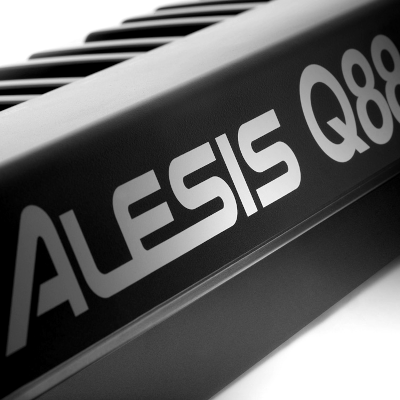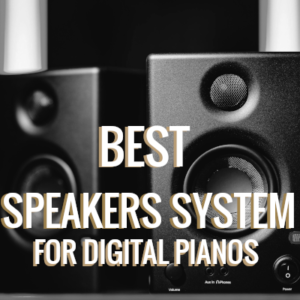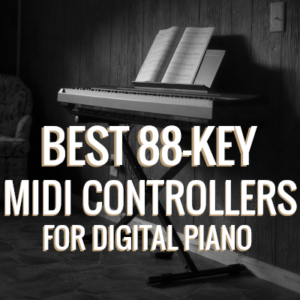The Best 88-Key MIDI Controllers for Digital Piano Integration in 2024
Author
* This post contains affiliate links, and we will be compensated if you buy after clicking on our links.

The capabilities of MIDI elevate digital pianos far beyond acoustics—linking you to endless creative tools and opportunities, turning your piano into a gateway to the entire music universe.
The right 88-key MIDI controller is essential for realistic piano feel and smooth integration with your digital setup. We’ll review the best options, “And thanks to my extensive experience, I can confidently and without hesitation say that the best choice is Roland A-88 MKII.
Let’s get into the 88-key MIDI controllers world.
-
Exceptional PHA-4 hammer action keyboard
-
Bluetooth MIDI connectivity
-
Innovative pitch/mod paddle controls
-
Comprehensive DAW control surface
-
Extensive sound library included
-
High-quality Fatar keybed
-
Deep integration with Komplete software
-
Dual high-res color screens
-
Smart chord and scale features
-
Affordable entry point
-
Simple plug-and-play setup
-
Lightweight and portable
💡 Quick Take: What Makes a Great 88-Key MIDI Controller?
- Hammer-action keys for authentic piano feel
- Robust connectivity and DAW integration
- Balancing features and price for your needs
Top Picks for 88-Key MIDI Controllers
- Roland A-88 MKII – Best Overall
- Arturia KeyLab 88– Best for Home Studios
- Native Instruments Komplete Kontrol S88 MK2 – Most Versatile
- Alesis Q88 MKII – Best Budget Option
- Studiologic SL-88 Studio – Best for Live Performances
⭐️ BEST OVERALL
A premium MIDI controller that sets the standard for professional performance. Features Roland’s renowned PHA-4 keyboard action and cutting-edge connectivity options.

Key Action Quality
Build Quality
Value for Money
DAW Integration
Extra Features
Overall
- What I Like
- Exceptional build quality
- Authentic piano feel
- Versatile connectivity
- What I Dislike
- Premium price point
- Steeper learning curve for advanced features.
The gold standard for serious musicians who demand the best.
⭐️ BEST FOR Home Studios
Perfect for home studio integration with comprehensive DAW controls and included software suite.

Key Action Quality
Build Quality
Value for Money
DAW Integration
Extra Features
Overall
- What I Like
- Excellent software bundle
- Intuitive control layout
- Premium key action.
- What I Dislike
- Large footprint
- Complex setup for some DAWs.
Your complete command center for professional music production.
⭐️ BEST Most Versatile
The ultimate controller for virtual instrument enthusiasts. Seamlessly integrates with Komplete software ecosystem.

Key Action Quality
Build Quality
Value for Money
DAW Integration
Extra Features
Overall
- What I Like
- Outstanding software integration
- Intuitive browsing, premium build.
- What I Dislike
- Highest price point
- Full potential requires NI software.
Welcome to the future of virtual instrument control.
⭐️ BEST Budget
An accessible entry point into the world of 88-key MIDI controllers.

Key Action Quality
Build Quality
Value for Money
DAW Integration
Extra Features
Overall
- What I Like
- Affordable
- Lightweight
- Simple setup.
- What I Dislike
- Basic key action
- Limited additional features.
Start your musical journey without breaking the bank.
⭐️ BEST Live Performance
A performer’s dream with reliability and portability in mind.

Key Action Quality
Build Quality
Value for Money
DAW Integration
Extra Features
Overall
- What I Like
- Outstanding key action
- Compact design
- Durable build
- What I Dislike
- Limited onboard controls
- Basic display
Your reliable partner on any stage.
Table of MIDI Controllers for Digital Piano Specs
Specification | Roland A-88 | Arturia KeyLab | NI S88 MK2 | Alesis Q88 | SL-88 Studio |
|---|---|---|---|---|---|
| Weight (kg) | 16.3 | 18.1 | 16.8 | 11.3 | 13.1 |
| Key Type | PHA-4 | Fatar TP/100LR | Fatar | Semi-weighted | TP/40WOOD |
| USB Ports | 2 | 3 | 2 | 1 | 2 |
| Display Type | LED | LCD | Dual Color | LED | OLED |
| Aftertouch | Yes | Yes | Yes | No | Yes |
| Power Options | USB/AC | USB/AC | USB/AC | USB | USB/AC |
Midi Controller for Digital Piano Brand Compatibility
The MIDI controllers featured in this roundup are universally compatible with the digital piano models from the major brands we cover – Yamaha, Kawai, Korg, Roland, and Nord. As long as a digital piano features standard MIDI connectivity, whether via traditional 5-pin MIDI ports or USB MIDI, these MIDI controllers will integrate seamlessly.
The key to compatibility lies in the universal MIDI protocol that all digital pianos and MIDI controllers adhere to. This ensures plug-and-play functionality, allowing you to connect any of these MIDI controllers to your Yamaha, Casio, Kawai, Korg, Roland, or Nord digital piano and immediately start using advanced MIDI features like DAW integration, assignable controls, and more.
No matter which digital piano brand you own, you can confidently pair it with any of the top MIDI controllers highlighted in this review, knowing they will work together flawlessly to enhance your music production and performance capabilities.
How to Choose the Best MIDI Controller for Digital Piano
Consider these factors when making your decision:
Key Size and Action
Evaluate the size and weight of the keys, and choose an action (hammer, semi-weighted, or velocity-sensitive) that mimics the feel of an acoustic piano.
Integration Capabilities
Ensure compatibility with your digital piano’s software and operating system. Consider features like MIDI input/output, USB connectivity, and pedal input.
Additional Controls
Look for extra features like pitch bend wheels, modulation wheels, and transport controls to enhance your playing experience.
Budget Constraints
Determine your budget and research controllers within your price range. Prioritize features that are essential to your playing style.
Space Requirements
Consider the size and portability of the controller, especially if you have limited space. Opt for a compact model if necessary.
Installation and Setup Guide
Getting Your MIDI Controller and Digital Piano Working Together
Setting Up Your MIDI Controller with a Digital Piano
Basic Connection Guide
Connecting your MIDI controller to your digital piano is a breeze. Simply use a standard MIDI or USB cable to link the two devices. Your digital piano’s MIDI or USB port will pair seamlessly with the MIDI controller.
Software Setup Tips
To unlock the full potential of your MIDI controller, you’ll likely need to install the accompanying software or drivers. Follow the manufacturer’s instructions to properly configure the controller with your preferred digital audio workstation (DAW) or music production suite.
Common Troubleshooting
If you encounter any connectivity issues, double-check your cable connections and ensure your digital piano’s MIDI/USB settings are configured correctly. Consult the manuals for both devices if you need help troubleshooting.
Optimization Suggestions
Customize your MIDI controller’s settings to perfectly match your playing style and digital piano. Adjust things like velocity curves, key sensitivity, and control assignments to optimize the integration.
Best Practices
Always power on your digital piano first before activating the MIDI controller. This ensures a smooth, glitch-free connection. Additionally, keep your software, drivers, and firmware up-to-date for the best performance.
With these simple steps, you’ll have your MIDI controller and digital piano working together in no time, ready to take your music creation to new heights.
Shopping Tips for Digital Piano Speakers
Key Action and Feel
The key action is crucial for a seamless transition from your digital piano. Look for semi-weighted or fully-weighted keys that mimic the responsive feedback of an acoustic piano.
Control Layout and Assignability
Evaluate the number and placement of assignable controls like knobs, sliders, and pads. Ensure the layout is intuitive and allows you to quickly access the functions you need.
Software Integration
Consider how well the MIDI controller integrates with your preferred music production software. Look for deep DAW integration that unlocks advanced features and automation.
Connectivity Options
Opt for a MIDI controller with both USB and traditional MIDI I/O ports. This ensures compatibility with a wide range of digital pianos and provides future-proofing.
Consider Your Space
If portability is a priority, look for compact, lightweight MIDI controllers with mini keys. For a primary studio setup, full-size keys will provide a more comfortable, piano-like experience.
Balance Features and Budget
Determine your must-have features and set a realistic budget. Premium MIDI controllers offer advanced capabilities, but excellent options are available at more affordable price points.
How I Tested These MIDI Controllers for Digital Pianos
As an experienced pianist with over 50 years of playing experience, I take the integration between MIDI controllers and digital pianos very seriously. When evaluating these top MIDI controllers, I put each one through a rigorous testing process to assess their real-world performance and suitability for digital piano players like myself.
The five key factors I used to assess the MIDI controllers were:
Key Action and Response
The feel and responsiveness of the keys are paramount for pianists. I meticulously tested the key action, velocity sensitivity, and overall playing experience of each MIDI controller to ensure a natural, piano-like feel.
Assignable Controls
Beyond just the keys, I examined the breadth and intuitiveness of the assignable controls like knobs, sliders, and pads. The ability to customize these elements for seamless DAW integration was a crucial consideration.
Software Integration
As a daily user of my Kawai CN33 digital piano, I have specific music production software preferences. I evaluated how each MIDI controller performed within my favored DAWs and virtual instrument suites.
Price-to-Value Ratio
Not everyone has an unlimited budget, so I carefully balanced the features, build quality, and performance of each MIDI controller against its price point. The goal was to identify the best value proposition for digital piano players.
Overall Build Quality
Durability and reliability are essential, especially for musicians who transport their gear frequently. I assessed the construction, materials, and long-term viability of each MIDI controller to ensure it could withstand the rigors of regular use.
Pro Tip Box: Expert Advice
Having spent more than five decades immersed in the world of pianos, I can assure you that investing in a high-quality MIDI controller can revolutionize your music-making. It turns your digital piano into a powerful tool for creating and producing, unlocking limitless creative opportunities. No matter if you’re just starting out or a seasoned musician, the right MIDI controller can take your playing to the next level and spark new inspiration. Explore these insights and recommendations to discover the ideal option for your needs.
FAQ
- Hammer-action keys simulate the feel of an acoustic piano, with weighted keys that require more pressure to depress, especially in the lower registers. This is ideal for pianists who want a realistic piano playing experience.
- Semi-weighted keys are lighter and require less pressure to depress, making them easier to play for extended periods. They are often preferred by keyboard players who need a balance between sensitivity and ease of play.
While MIDI controllers are often used with Digital Audio Workstations (DAWs) for music production and recording, they can also be used without a DAW. They can be connected directly to a digital piano or keyboard to control sounds and parameters. However, the extent of functionality will depend on the specific controller and the device it’s connected to.
For beginners, a good option is the M-Audio Keystation 88 MK3. It offers a balance of features and affordability, with full-size, velocity-sensitive keys and MIDI connectivity. It’s easy to use and compatible with most music software.
The lifespan of a MIDI controller depends on various factors, including usage, maintenance, and the quality of the build. With proper care, a good MIDI controller can last for many years. High-quality controllers from reputable brands tend to have longer lifespans.





